|
I first became aware of the 1964-65 New
York World's Fair when I worked as Director of Television and
Motion Pictures for the 1962 Seattle World's Fair in Washington.
The New York Fair had a small exhibit there ... mainly a plexiglas
covered model about 6' X 4', posters and brochures. But having
had a taste of the World's Fair excitement from Seattle, I knew
that I would want to have some sort of association with the New
York venture.
Cantinflas
Photo taken with the internationally
famous Mexican film star Cantinflas during production of the NBC
Television special: "Opening Night At The New York World's
Fair." Shot was taken at the African Pavilion in late
winter, around February or March, 1964 prior to the Fair opening.
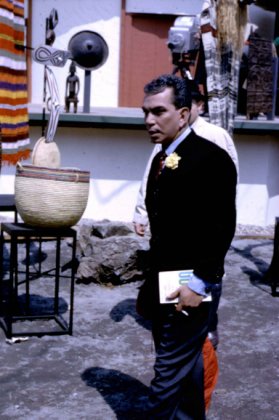 |
After the Seattle Fair, in the fall of
1962, I moved to New York City as Producer and head Talent Scout
for the CBS television series: "Ted Mack and The Original
Amateur Hour." I had a roommate, Phil Bodwell who landed
a job as a Producer of the planned 90-minute "Opening
Night Special" from the New York Fair for NBC to be
sponsored by USS Steel, the makers of the Unisphere. I managed
to convince Bob Benedict, the Executive Producer of the show
that he needed my experience from Seattle on the program and
landed a job as one of the other Producers. We shot from February
to mid April of 1964. The show was to air "live," with
most of the elements pre-filmed and the "live" portion
to be lead-ins and lead-outs hosted by Henry Fonda. Guest star
hosts on the segments included Carol Channing (representing the
industrial section), Fred Mac Murray (Transportation), Lorne
Greene (States), Marion Anderson (Religion) and the Mexican film
star Cantinflas (International). I had a chance to work with
them all. Probably the hardest thing for all of us to do was
to shoot in the freezing cold of winter weather and pretend that
it was a balmy late April day for the cameras. It was difficult
to keep everyone's breath from showing on the film, but we pulled
it off. Channing had a song to do on the roof of the Kodak Pavilion
on a Sunday afternoon when it must have been well below freezing.
Her husband, Charles Lowe, kept pulling me aside saying he was
going to pull her off the roof any minute now because he was
concerned that her voice would be affected by the cold and she
had a full schedule of stage appearances in "Hello Dolly"
on Broadway which was the big hit at the time. She persevered
however and was delightful. The famous motion picture star Fred
Mac Murray had a more difficult time.
I had to get him to go up on top of the
Chrysler Pavilion for a sequence. The only way up was a ladder.
Fred did not like heights and it took a lot of coaxing to get
him up to the top, but he finally made it. The shot was done
from the roof of the Heliport looking down on Mac Murray on the
Chrysler building. Because of the angle, we had to get rid of
the ladder once Fred was up on top and I was one of the few people
allowed up on top with him because we did not want to see anyone
other than Fred on the roof on camera. So here we were ... trapped
on the roof of the Chrysler Pavilion ... when Fred whispered
that he had a "problem." Seems that he had severe bowel
problems that day and had "the runs." There was no
toilet on top and Fred "had to go ... now!" I found
a workman's left over metal pail on the roof and, with a coat
cover to protect what little decency was left of the poor man,
Fred Mac Murray, one of America's greatest actors, had to relieve
himself in a metal pail in the freezing cold on the roof of the
Chrysler Pavilion. He maintained his dignity throughout and swore
us to secrecy about the incident. I think that this is the first
time that oath of secrecy has been broken.
Opening day, April 22, 1964 was a disaster.
Protesters were taking axes and cutting the cables of our cameras
prior to our going on the air "live." It was raining
and the expected crowds stayed away from the Fair, which made
it look cold, wet and deserted. Henry Fonda, one of the world's
greatest actors and the consummate showman, never complained
and forged ahead with rehearsals. I stood on the press platform
for the opening day ceremonies, just a few feet away from every
dignitary from Presidents Truman and Eisenhower to Indira Ghandi
of India. It was exhilarating for a young man to witness this
up-close. The show did air as scheduled that night and pulled
tremendous ratings and was a huge success.
While all of the shooting over the months
prior to the opening was going on, I had opened up discussions
with Bill Berns, the VP of Public Relations and Communications
for the Fair, Tom Deegan, Chairman of the Executive Committee
whose company ran press, and John O'Keefe who headed up TV. After
so much badgering by me, they finally let me join O'Keefe in
the TV department the day after opening day. That started my
full-time work for the Fair corporation.
My job was to get TV shows to talk up the
Fair and to originate from the Fair. In the beginning, this was
an easy task as everyone wanted to come see the Fair and were
anxious to help promote it. We did origination's with shows such
as "Today," "Candid Camera," "Queen
For A Day," "To Tell The Truth" (I even appeared
as an impostor on this show and established a lifelong close
friendship with the host, Bud Collyer and his family).
(l to r) Joan Crawford, Albert
Fisher
This photo was taken at Joan's
penthouse apartment on 5th Avenue when we recorded her narration
for the official radio series for The New York World's Fair, "World's
Fair Holiday." Taken in the fall of 1964.
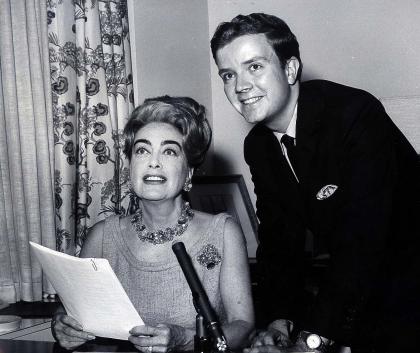 |
Another aspect of my job was to take TV
stars around the Fair in the hopes that they would promote the
Fair on their respective shows. At the same time, I began chronicling
my time with some of these stars in a series of audio interviews
which I would later weave into a radio series: "World's
Fair Holiday," the official radio series of the Fair
which was distributed to stations around the world. As hosts
of the series, I obtained screen actress and legend Joan Crawford,
singer Pat Boone, TV hostess Arlene Francis and my friend, TV
game show host Bud Collyer. I wrote, produced and directed the
20 episodes of the series. Additionally, I interviewed people
like Leonard Bernstein, Louis Armstrong, and Tippi Hedren of
the movie "The Birds" fame. Tippi brought along her
7 year old daughter who I also interviewed. Her name is Melanie
Griffith.
(l to r) Albert Fisher, Gower
Champion, Marge Champion, Gordon MacRae, Carol Channing
Marge and Gower Champion were
amazing dancers and choroeographers for Broadway and Films. Gower
was also one of the top stage and screen directors. Gordon MacRae
was one of the biggest names on Broadway, movies and TV. Carol
Channing remains one of the great stage stars whose fame hit the
top with "Hello Dolly." This photo was taken
at the Gas Pavilion in the summer of 1964.
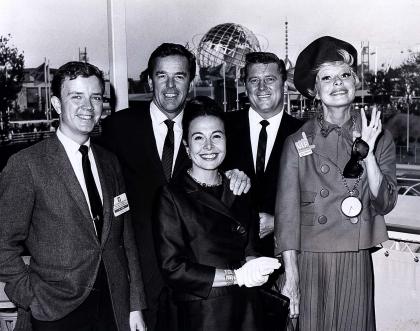 |
Almost all of the pavilions at the Fair
had VIP lounges where we could bring our visiting dignitaries.
The best of these were at the bigger industrial exhibits: Ford,
General Motors, Electric Light, Pepsi, Bell Telephone, etc. My
favorite two restaurants at the Fair turned out to be the Gas
Pavilion (run by Restaurant Associates) and the famed Spanish
Pavilion restaurant. I remember taking Carol Channing to the
Spanish Pavilion. The previous week, I had been there with Ed
Sullivan and the folks at the restaurant could not do enough
to try and impress him. I knew that they would turn out the same
kind of amazing Spanish hospitality for Channing. What I did
not know was that they would invite the press to come to see
Broadway's biggest star, Carol Channing, eat at their magnificent
restaurant. And further, what I also did not know was that Carol
was on a special diet. When we arrived at the restaurant, Carol
had a large canvas bag with her. We sat down at the best table
in the restaurant ... right in the middle where everyone could
see her ... and she proceeded to pull from this bag her own dinner!
She would not have anything to do with the Spanish food. There
were immediate diplomatic hurdles to overcome and I thought that
the manager of the restaurant was going to send me into a ring
with the bulls. However, I did finally manage to have them set
a plate of Spanish food in front of Carol for the photographers
to shoot and, afterwards, she continued to eat her own plain
broiled chicken and hard-boiled eggs.
(l to r) Albert Fisher, Red
Skelton
Photo taken in the restaurant
at the Gas Pavilion, summer 1964.
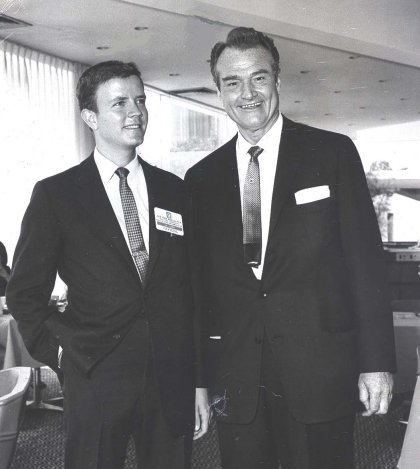 |
The day I spent with the legendary comic
and TV star Red Skelton and his son at the Fair was one of mixed
emotions. I was excited about being with Skelton but was also
aware of the fact that Red was on an extended leave of absence
from his TV series so he could spend time with his son who was
dying of Leukemia. Every place we visited, throngs of admirers
confronted Skelton and he was always happy to give autographs
and pose for pictures. Inside, he must have been in anguish knowing
that his time with his little boy was limited. Within 6 months,
the boy passed away. Skelton was well known as an artist who
painted clowns. I always felt that this was a prime example of
the classic tale of the clown laughing on the outside and crying
on the inside.
(l to r) Merv Griffin, Albert
Fisher
Photo with Merv at the fountains
near the Unisphere. In the background is the Johnson's Wax pavilion.
Summer, 1964.
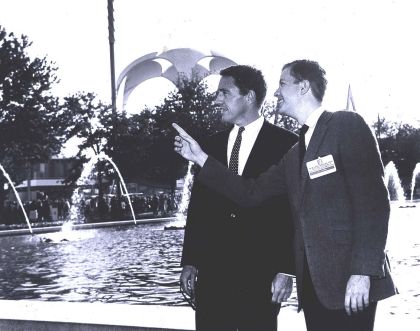 |
I had met Merv Griffin at the Seattle World's
Fair two years earlier. I did not know who he was and spent an
entire day taking him around the Fair with a camera crew from
The Tonight Show and everywhere we went, I introduced
him as "Marv Griffith." My innocent error laid the
foundation for a friendship that would last a lifetime. I took
Merv and his family on many trips around the New York World's
Fair and when my stint at the Fair ended, Merv offered me the
job as head of promotion, publicity and public relations for
his soon-to-start TV series: "The Merv Griffin Show."
I remained with Merv for 5 years and, to this day, still consider
him to be one of the most influential people in my life.
|